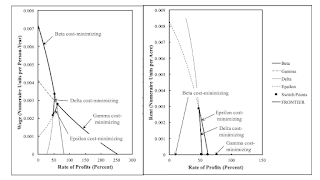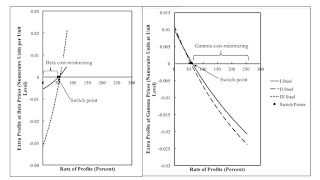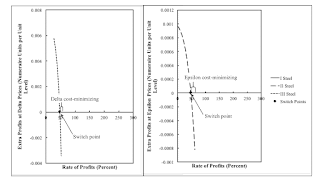Figure 1: The Wage Frontier And Rent This post is merely a worked homework example, problem 7.10 in Kurz and Salvadori (1995). I have not considered yet which parameters I want to explore perturbing. As a matter of history, Anderson, West, Malthus, and Ricardo took extensive rent as the paradigm case, and confined it to land. They imposed no limit on the production of industrial commodities. Ricardo, at least, also discussed the case of intensive rent. The marginalists, on the other hand, took the case of intensive rent as the paradigm case and extended it to all commodities and, sloppily, extended the explanation of rent to payments to capital and labor. I still do not get well-behaved supply and demand relationships in models of intensive rent. Marginalism remains mistaken and lacks a
Topics:
Robert Vienneau considers the following as important: Example in Mathematical Economics, Joint Production, Sraffa Effects
This could be interesting, too:
Robert Vienneau writes Austrian Capital Theory And Triple-Switching In The Corn-Tractor Model
Robert Vienneau writes Double Fluke Cases For Triple-Switching In The Corn-Tractor Model
Robert Vienneau writes The Emergence of Triple Switching and the Rarity of Reswitching Explained
Robert Vienneau writes Recap For A Triple -Switching Example
| Figure 1: The Wage Frontier And Rent |
This post is merely a worked homework example, problem 7.10 in Kurz and Salvadori (1995). I have not considered yet which parameters I want to explore perturbing.
As a matter of history, Anderson, West, Malthus, and Ricardo took extensive rent as the paradigm case, and confined it to land. They imposed no limit on the production of industrial commodities. Ricardo, at least, also discussed the case of intensive rent. The marginalists, on the other hand, took the case of intensive rent as the paradigm case and extended it to all commodities and, sloppily, extended the explanation of rent to payments to capital and labor. I still do not get well-behaved supply and demand relationships in models of intensive rent. Marginalism remains mistaken and lacks a coherent price theory.
Table 1 presents coefficients of production for the technology. One process is known for producing iron, three processes are known for producing steel, and one process is known for producing corn. Iron and steel are industrial commodities, while corn is the single agricultural commodity. One hundred acres of land are available. All processes exhibit constant returns to scale, in corn production up to the limit imposed by the scarcity of land. The scarity of land can result in a combination of two processes being used to produce steel, with land receiving a positive rent. Requirements for use are 10 tons iron, 10 tons steel, and 78 bushels corn. I take requirements for use, that is, net output, as the numeraire.
| Input | Industries and Processes | ||||
| Iron | Steel | Corn | |||
| I | II | III | |||
| Labor | 1 | 1 | 1/10 | 11/2 | 1 |
| Land | 0 | 0 | 0 | 0 | 1 |
| Iron | 0 | 3/10 | 2/5 | 1/10 | 1/10 |
| Steel | 1/10 | 3/10 | 2/5 | 1/10 | 1/10 |
| Corn | 0 | 2/5 | 3/10 | 1/5 | 1/10 |
Six techniques are available for a sustainable economy. In each technique, the iron-producing and corn-producing processes are operated. The techniques are distinguishable by the steel-producing or combination of steel-producing processes that are operated (Table 2).
| Technique | Steel Process(es) |
| Alpha | I |
| Beta | II |
| Gamma | III |
| Delta | I, II |
| Epsilon | I, III |
| Zea | II, III |
The Alpha technique is not feasible; requirements for use cannot be satisified by operating the specified combination of processes while respecting the constraint imposed by land. The Beta, Gamma, Delta, and Epsilon techniques are feasible. When the Beta or Gamma techniques are operated to produce the requirements for use, some land is left farrow and rent is zero. The Delta and Epsilon techniques each require all land to be farmed. Zeta produces more commodities than are required for use. It would only be adopted at a switch point between Beta and Gamma, with a rent of zero.
Prices of production for the Beta and Gamma techniques can be analyzed as in models of circulating capital. For the Beta technique, for example, each of the iron-producing, steel-producing, and corn-producing processes provides a price equation. With the specification of the numeraire, one has four equations in five unknowns: the price of iron, the price of steel, the price of corn, the wage, and the rate of profits. Rent is zero, since land is in excess supply. One can solve for each variable as a function of the rate of profits. As shown in Figure 1 at the top of this post, the wage curves for the Beta and Gamma techniques slope down.
When are the Beta and Gamma techniques cost-minimizing? For a given rate of profits, one can calculate, for each process, the difference between revenues and costs, where costs include a charge for profits on the iron, steel, and corn advanced. The Beta technique, for example, is cost-minimizing only when extra profits cannot be made in operating any process. Figure 2 shows the ranges of the rates of profits at which the Beta and Gamma techniques are cost-minimizing.
| Figure 2: Extra Profits At Beta Or Gamma Prices |
Prices of production can also be found for the Delta and Epsilon techniques. For the Delta technique, for example, the iron-producing, the first and second steel-producing, and the corn-producing processes provide a price equation. Given the rate of profits and the specification of the numeraire, the wage and the prices of iron, steel, and corn, can be solved for from the iron-producing and steel-producing processes. The corn-producing process then yields the rent per acre of land. I confine my attention to non-negative rents and prices. For the Delta technique, rent is negative at a rate of profits of zero, but not for a certain range of postive rates of profits.
| Figure 3: Extra Profits At Delta Or Epsilon Prices |
To find when the Delta technique is cost-minimizing, one performs the usual analysis. When can extra profits, at Delta prices, be made by operating a process not in the technique? The left-hand panel in Figure 3 shows that extra profits are available from the third steel-producing processes for start of the range of the rate of profits at which the Delta technique yields positive rents. At the end of this range, the Delta technique is cost-minimizing. One can repeat this analysis for the Epsilon technique. The Epsilon technique is cost-minimizing at towards the end of the range for the rate of profits at which it yields a positive rent, as shown in the right-hand panel in Figure 3.
Even though the choice of technique is not analyzed above by construction of an envelope of wage curves, one can still highlight wage curves for each technique when they are cost-minimizing. The left-hand panel in Figure 1, at the top of this post, shows the resulting wage frontier. The right-hand panel shows rent as a function of the rate of profits.
The wage curve for the Delta technique slopes up, even when it is on the frontier. You can see that there is a certain range of the rate of profits where the Beta, Delta, and Epsilon techniques are each cost-minimizing. The wage could just as well be taken as the independent variable. And there is a range of the wage where the Delta, Epsilon, and Gamma techniques are cost-minimizing. Sraffa was wrong or, at least, misleading in certain comments on intensive rent in his book on intensive rent. Some, but not all, of the analytical tools he built can be used to demonstrate these mistakes.
This post illustrates that in a model of external intensive rent, prices of production, rent, and the wage are not necessarily uniquely determined by the rate of profits. Nor are prices of production, rent, and the rate of profits necessarily uniquely determined by the wage. This non-uniqueness cannot arise in circulating capital models or pure fixed capital systems. It can only arise in a model of extensive rent in a fluke case that I have been calling a pattern for the requirements for use.
 Heterodox
Heterodox



